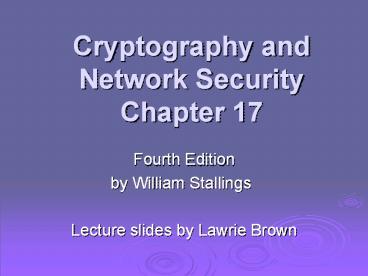Cryptography and Network Security Chapter 17 - PowerPoint PPT Presentation
Title:
Cryptography and Network Security Chapter 17
Description:
to protect Internet credit card transactions. developed in 1996 by Mastercard, Visa etc ... merchant provides goods or service. merchant requests payment. Dual ... – PowerPoint PPT presentation
Number of Views:661
Avg rating:3.0/5.0
Title: Cryptography and Network Security Chapter 17
1
Cryptography and Network SecurityChapter 17
- Fourth Edition
- by William Stallings
- Lecture slides by Lawrie Brown
2
Chapter 17 Web Security
- Use your mentality
- Wake up to reality
- From the song, "I've Got You under My Skin by
Cole Porter
3
Web Security
- Web now widely used by business, government,
individuals - but Internet Web are vulnerable
- have a variety of threats
- integrity
- confidentiality
- denial of service
- authentication
- need added security mechanisms
4
SSL (Secure Socket Layer)
- transport layer security service
- originally developed by Netscape
- version 3 designed with public input
- subsequently became Internet standard known as
TLS (Transport Layer Security) - uses TCP to provide a reliable end-to-end service
- SSL has two layers of protocols
5
SSL Architecture
6
SSL Architecture
- SSL connection
- a transient, peer-to-peer, communications link
- associated with 1 SSL session
- SSL session
- an association between client server
- created by the Handshake Protocol
- define a set of cryptographic parameters
- may be shared by multiple SSL connections
7
SSL Record Protocol Services
- message integrity
- using a MAC with shared secret key
- similar to HMAC but with different padding
- confidentiality
- using symmetric encryption with a shared secret
key defined by Handshake Protocol - AES, IDEA, RC2-40, DES-40, DES, 3DES, Fortezza,
RC4-40, RC4-128 - message is compressed before encryption
8
SSL Record Protocol Operation
9
SSL Change Cipher Spec Protocol
- one of 3 SSL specific protocols which use the SSL
Record protocol - a single message
- causes pending state to become current
- hence updating the cipher suite in use
10
SSL Alert Protocol
- conveys SSL-related alerts to peer entity
- severity
- warning or fatal
- specific alert
- fatal unexpected message, bad record mac,
decompression failure, handshake failure, illegal
parameter - warning close notify, no certificate, bad
certificate, unsupported certificate, certificate
revoked, certificate expired, certificate unknown - compressed encrypted like all SSL data
11
SSL Handshake Protocol
- allows server client to
- authenticate each other
- to negotiate encryption MAC algorithms
- to negotiate cryptographic keys to be used
- comprises a series of messages in phases
- Establish Security Capabilities
- Server Authentication and Key Exchange
- Client Authentication and Key Exchange
- Finish
12
SSL Handshake Protocol
13
TLS (Transport Layer Security)
- IETF standard RFC 2246 similar to SSLv3
- with minor differences
- in record format version number
- uses HMAC for MAC
- a pseudo-random function expands secrets
- has additional alert codes
- some changes in supported ciphers
- changes in certificate types negotiations
- changes in crypto computations padding
14
Secure Electronic Transactions (SET)
- open encryption security specification
- to protect Internet credit card transactions
- developed in 1996 by Mastercard, Visa etc
- not a payment system
- rather a set of security protocols formats
- secure communications amongst parties
- trust from use of X.509v3 certificates
- privacy by restricted info to those who need it
15
SET Components
16
SET Transaction
- customer opens account
- customer receives a certificate
- merchants have their own certificates
- customer places an order
- merchant is verified
- order and payment are sent
- merchant requests payment authorization
- merchant confirms order
- merchant provides goods or service
- merchant requests payment
17
Dual Signature
- customer creates dual messages
- order information (OI) for merchant
- payment information (PI) for bank
- neither party needs details of other
- but must know they are linked
- use a dual signature for this
- signed concatenated hashes of OI PI
- DSE(PRc, H(H(PI)H(OI)))
18
SET Purchase Request
- SET purchase request exchange consists of four
messages - Initiate Request - get certificates
- Initiate Response - signed response
- Purchase Request - of OI PI
- Purchase Response - ack order
19
Purchase Request Customer
20
Purchase Request Merchant
- verifies cardholder certificates using CA sigs
- verifies dual signature using customer's public
signature key to ensure order has not been
tampered with in transit that it was signed
using cardholder's private signature key - processes order and forwards the payment
information to the payment gateway for
authorization (described later) - sends a purchase response to cardholder
21
Purchase Request Merchant
22
Payment Gateway Authorization
- verifies all certificates
- decrypts digital envelope of authorization block
to obtain symmetric key then decrypts
authorization block - verifies merchant's signature on authorization
block - decrypts digital envelope of payment block to
obtain symmetric key then decrypts payment
block - verifies dual signature on payment block
- verifies that transaction ID received from
merchant matches that in PI received (indirectly)
from customer - requests receives an authorization from issuer
- sends authorization response back to merchant
23
Payment Capture
- merchant sends payment gateway a payment capture
request - gateway checks request
- then causes funds to be transferred to merchants
account - notifies merchant using capture response
24
Summary
- have considered
- need for web security
- SSL/TLS transport layer security protocols
- SET secure credit card payment protocols

